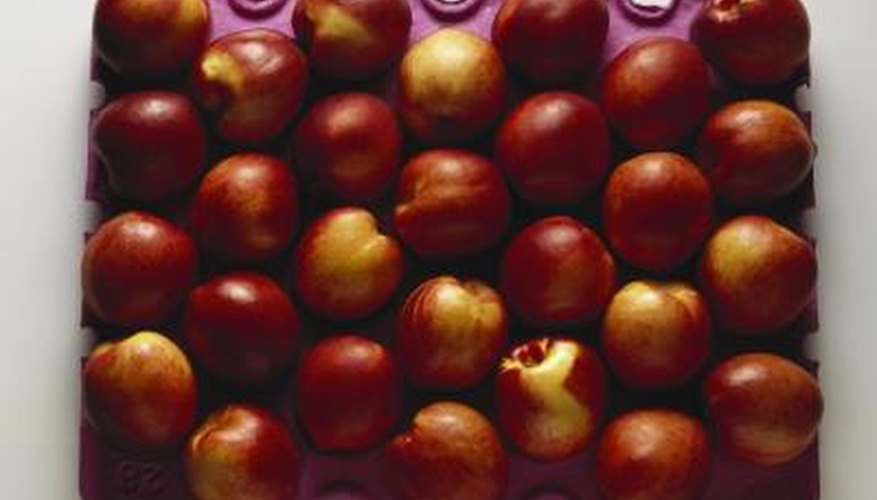Growing nectarines in the home landscape can be a rewarding and practical undertaking. Nectarine trees prefer certain soil, site and nutritional conditions like full sun, adequate drainage and a near-neutral soil pH. Ensuring that a tree's site requirements are met will increase its ability to withstand pest or disease problems like the multiple pathogens, pests or conditions that can cause nectarine foliage to suffer from yellowing.
Bacterial Leaf Spot
Bacterial leaf spots result from a bacterium, Xanthomonas campestris pv. pruni, which first causes black or brown angular spots before tips of leaves die and leaves turn yellow and drop. A heavy infection can cause complete leaf drop. Fruit may have spots and be pitted. Frequent rainfall, particularly in spring, will greatly encourage spread of the bacterium. Bacterial leaf spot on nectarines cannot be completely controlled, although copper sulphate sprays when flowers emerge may help to suppress the disease.
- Bacterial leaf spots result from a bacterium, Xanthomonas campestris pv.
- Bacterial leaf spot on nectarines cannot be completely controlled, although copper sulphate sprays when flowers emerge may help to suppress the disease.
Leaf Curl
Leaf curl, caused by the fungus Taphrina deformans, appears on leaves and shoots when they emerge in the spring. Foliage is puckered, thickened and pale green to yellow. A powdery fungal material develops on the leaves, which eventually shrivel and drop. Fruit yield and quality will also be impacted. This fungus is most prevalent when springs are cool and damp. Although already infected leaves are not treatable, recurrence may be prevented with a spray of lime-sulphur solution immediately after leaf drop in fall or before bud swell in spring.
- Leaf curl, caused by the fungus Taphrina deformans, appears on leaves and shoots when they emerge in the spring.
Aphids
Aphids are tiny yellow, black or green soft-bodied insects that cluster on new growth and leaf undersides and excrete a shiny, sticky substance that hosts sooty mould. A heavy aphid infestation can cause leaf distortion, yellowing and drop; fruit may be small and misshapen. A forceful spray of water can dislodge the aphids, which are generally too weak to return to the tree. Aphid infestations can also be treated with applications of horticultural oil, neem oil and, if necessary, a number of insecticides.
- Aphids are tiny yellow, black or green soft-bodied insects that cluster on new growth and leaf undersides and excrete a shiny, sticky substance that hosts sooty mould.
- A forceful spray of water can dislodge the aphids, which are generally too weak to return to the tree.
Nutritional Deficiency
Leaf yellowing and drop could be caused by a nutrient deficiency like a lack of nitrogen or iron. Lower, older leaves on a nectarine tree will turn yellow first if nitrogen is insufficient. An iron deficiency, especially common in alkaline soils, may be indicated by leaf tissue that turns yellow while veins remain green. If a nutrient deficiency is suspected, have the soil tested and perform amendments as recommended. Nectarines generally require a balanced fertiliser like a 10-10-10 applied each year in early spring.
- Leaf yellowing and drop could be caused by a nutrient deficiency like a lack of nitrogen or iron.
- An iron deficiency, especially common in alkaline soils, may be indicated by leaf tissue that turns yellow while veins remain green.
Inadequate Watering
Improper watering or, conversely, poorly-drained soils, can cause leaf yellowing and drop. Young, recently planted trees should be irrigated weekly for at least six weeks after transplant. Otherwise, trees should receive 1 inch of water every two to three weeks. Adequate water is extremely important to mature trees throughout several weeks leading up to harvest.
- Improper watering or, conversely, poorly-drained soils, can cause leaf yellowing and drop.
- Young, recently planted trees should be irrigated weekly for at least six weeks after transplant.
